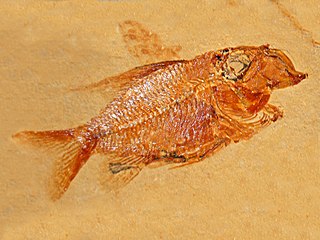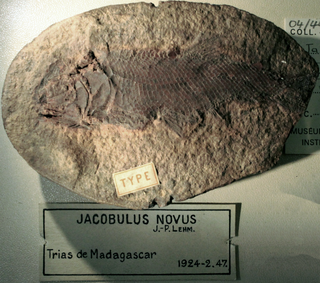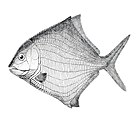
Lissoberyx is an extinct genus of prehistoric ray-finned fish belongon to the family Trachichthyidae. Lissoberyx is a trachichthyid, but it shows more resemblance to the holocentrids than any other trachichthyid.
Stensionotus is an extinct genus of prehistoric bony fish that lived during the Early Triassic epoch in what is now Madagascar and China. It belongs to Parasemionotidae together with Albertonia, Candelarialepis, Jacobulus, Lehmanotus, Parasemionotus, Qingshania, Suius, Thomasinotus and Watsonulus. It is named after Erik Stensiö.

Watsonulus is an extinct genus of prehistoric ray-finned fish that lived during the Early Triassic epoch in what is now Madagascar. It may have also existed in what is now Himachal Pradesh, India, during the Induan age. The type species, described by Jean Piveteau, is Watsonia eugnathoides. Because "Watsonia" was preoccupied, the new genus name Watsonulus was later erected. The genus is named after David Meredith Seares Watson.
Lehmanotus is an extinct genus of prehistoric bony fish that lived during the Early Triassic epoch in what is now Madagascar. It belongs to Parasemionotidae together with Albertonia, Candelarialepis, Jacobulus, Parasemionotus, Qingshania, Stensioenotus, Suius, Thomasinotus and Watsonulus. It is named after Jean-Pierre Lehman.
Broughia is an extinct genus of marine holostean ray-finned fish that lived during the Induan age of the Early Triassic epoch in what is now Greenland. Fossils were found in the Wordie Creek Formation. A potential concurrent record is also known from Madagascar.

Jacobulus is an extinct genus of prehistoric ray-finned fish that lived during the Early Triassic epoch in what is now northern Madagascar 252.3 to 251.3 million years ago. The type species is Jacobulus novus (monotypy). It was a small fish less than 10 centimetres (3.9 in) in length. J. novus ecology was a grazer-detritivore. It belongs to the Parasemionotidae together with Albertonia, Candelarialepis, Icarealcyon, Lehmanotus, Parasemionotus, Qingshania, Stensioenotus, Suius, Thomasinotus, and Watsonulus.

Australosomus is an extinct genus of prehistoric ray-finned fish that lived during the Early Triassic epoch in what is now Greenland, Kenya, Tanzania, Madagascar, South Africa and Canada.
Helmolepis is an extinct genus of ray-finned fish that lived during the Early Triassic epoch in what is now Greenland, Madagascar and Canada. Species of Helmolepis are small. This genus is closely related with Platysiagum.
Sakamenichthys is an extinct genus of prehistoric bony fish that lived during the Early Triassic epoch in what is now Madagascar. Fossils were recovered from beds of the Middle Sakamena Formation of the Beroroha basin in the southern part of the island.

Pteronisculus is an extinct genus of prehistoric ray-finned fish that lived during the Early Triassic and Middle Triassic epochs of the Triassic period worldwide.
Eosaurichthys is an extinct genus of saurichthyid ray-finned fish that lived during the late Permian epoch in what is now China.

Parasemionotus is an extinct genus of prehistoric bony fish that lived in the Induan age of the Early Triassic epoch in what is now Madagascar. It is the name giving genus of the family Parasemionotidae and the order Parasemionotiformes.

Paracentrophorus is an extinct genus of prehistoric ray-finned fish that lived during the Induan age of the Early Triassic epoch in what is now Madagascar. The type species is Paracentrophorus madagascariensis (monotypy).

Thomasinotus is an extinct genus of small prehistoric ray-finned fish that lived in the Induan age of the Early Triassic epoch in what is now Madagascar. It belongs to the early neopterygian family Parasemionotidae together with Albertonia, Candelarialepis, Icarealcyon, Jacobulus, Lehmanotus, Parasemionotus, Qingshania, Stensioenotus, Suius, and Watsonulus.

Bobasatrania is an extinct genus of prehistoric marine ray-finned fish that survived the Permian-Triassic extinction event. Fossils of Bobasatrania were found in beds of Changhsingian to Ladinian age. It was most speciose during the Early Triassic.

Boreosomus is an extinct genus of Triassic marine ray-finned fish. It was first described from the Arctic island of Spitsbergen, hence its genus name, but was later also discovered in other parts of the world. The type species is Boreosomus arcticus.

Colobodus is an extinct genus of marine Triassic ray-finned fish of the family Colobodontidae and order Perleidiformes. Fossils have been found in Europe and China, encompassing the former Tethys Ocean. It could reach body lengths of about 70 cm.

Hemicalypterus is an extinct genus of prehistoric ray-finned fish that lived during the late Triassic period. It contains a single species, Hemicalypterus weiri. Fossils have been collected in the southwestern United States, including Utah and New Mexico. Hemicalypterus belonged to the family Dapediidae, and like other members of its family, it was a deep-bodied fish with a covering of thick ganoid scales. It differed from other dapediids in lacking scales on the posterior part of the body, and in possessing unusual, multicuspid teeth. These teeth were similar to those of modern-day herbivorous fish, which indicates that Hemicalypterus may have been a herbivore as well.

Ptycholepis is an extinct genus of prehistoric ray-finned fish having the head and opercular bones ornamented with ridges of ganoin, minute teeth, and thick scales.
Egertonia is an extinct genus of prehistoric bony fish. The earliest occurrences of the genus in the fossil record are from the Late Cretaceous of Madagascar and India.





















